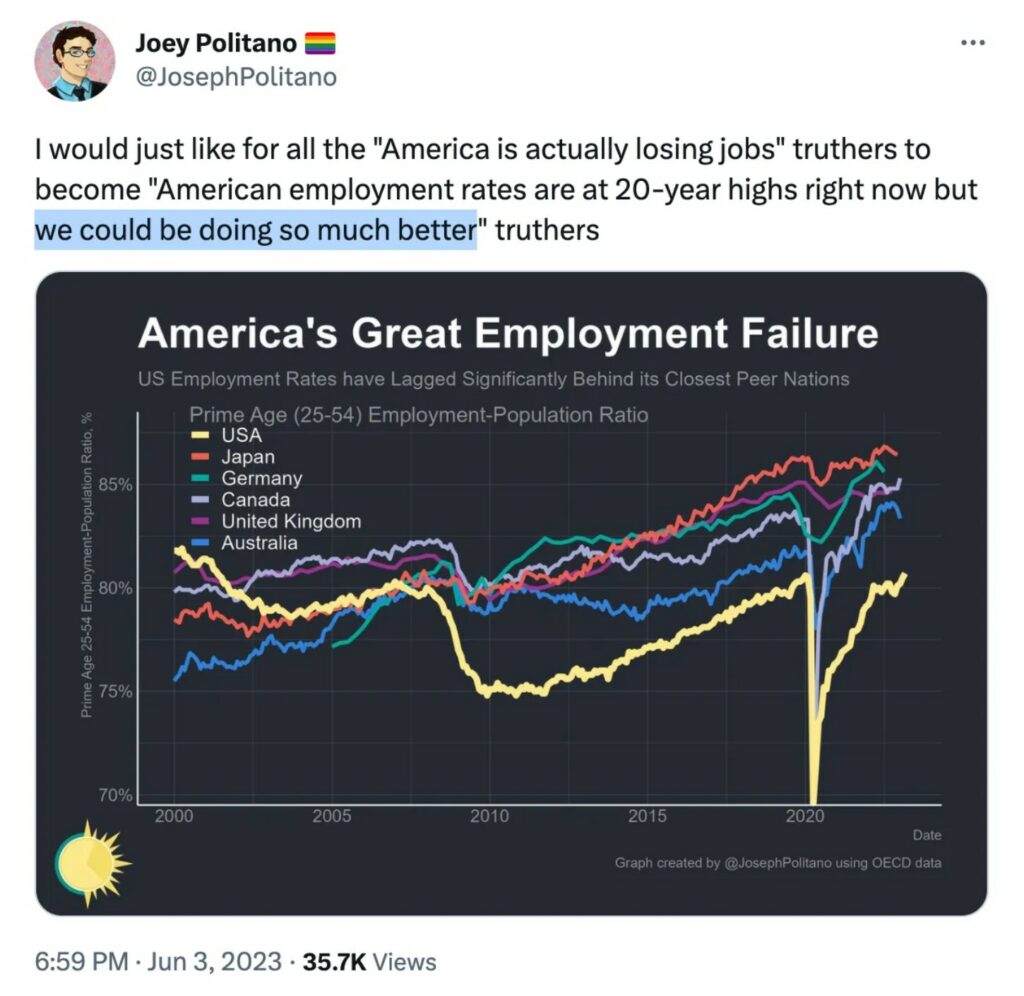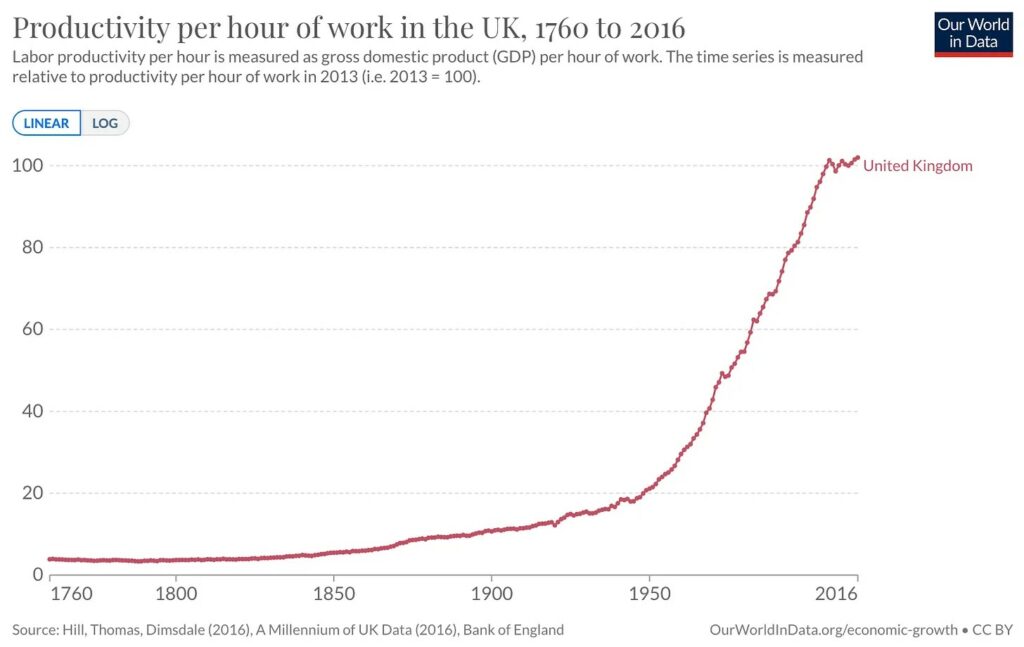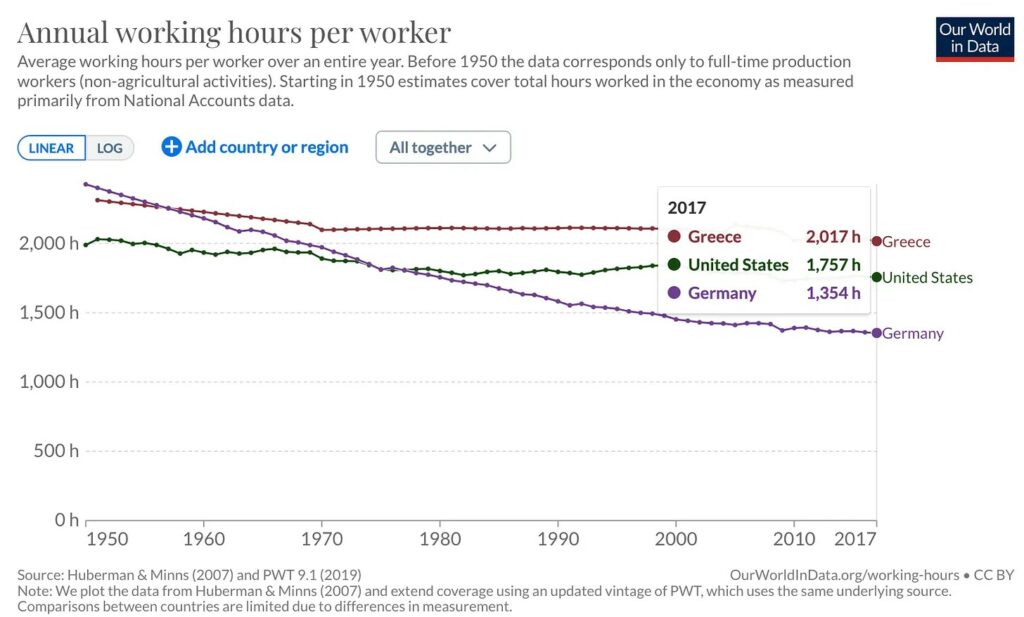Is More Work Better? Think Again? The freedom of free time, branded as unproductive “leisure,” gets no respect. Originally published at Wealth Economics This post is prompted by a recent tweet from the excellent Joey Politano, but it’s not singling out Joey in particular. “We could be working so much more.” It’s hard to come away with any other message. This tweet’s just one example of a lurking, largely unspoken, and quite likely unconscious value assumption that seems nearly universal among economists, pundits, politicians, and…people: more work is better. Sure: if people need to work for wages to make a living, and they can’t get a job, that’s a bad thing. Hence the “jobs” focus of politicians and people in general. But do
Topics:
Steve Roth considers the following as important: Education, US/Global Economics, work
This could be interesting, too:
Joel Eissenberg writes How Tesla makes money
Angry Bear writes True pricing: effects on competition
Angry Bear writes The paradox of economic competition
Angry Bear writes USMAC Exempts Certain Items Coming out of Mexico and Canada
Is More Work Better? Think Again?
The freedom of free time, branded as unproductive “leisure,” gets no respect.
Originally published at Wealth Economics
This post is prompted by a recent tweet from the excellent Joey Politano, but it’s not singling out Joey in particular.
“We could be working so much more.” It’s hard to come away with any other message. This tweet’s just one example of a lurking, largely unspoken, and quite likely unconscious value assumption that seems nearly universal among economists, pundits, politicians, and…people: more work is better.
Sure: if people need to work for wages to make a living, and they can’t get a job, that’s a bad thing. Hence the “jobs” focus of politicians and people in general. But do people work jobs because they need to, or because they want to? To some (great?) extent, it’s about need. So, we could look at the picture above, and celebrate: “Wow. Americans don’t need to work nearly as much as people in other countries. Freedom and prosperity!”
The bias is baked into economists’ very terms of art: in their lingo, the alternative to work is “leisure.” To some extent at least, it inevitably smacks of unproductive laziness. How about “free time” instead? Free time smacks of freedom. What’s not to like?
Measuring Betterness
The “great transformation” that has transfigured the world since the industrial revolution was arguably about one big thing: “productivity.” (Click for source).
This graph is slightly mislabeled; it actually shows an index of output per hour worked, which equals labor productivity (by definition).1 There’s a numerator, and a denominator. Which means increased productivity could reflect increased output (more stuff), or less hours worked (more free time). The latter is rarely considered in a positive vein.
In a more freedom-friendly view of work-life balance, there’s real value in extra time with family, friends, and loved ones, and time doing the things we love. It’s something we should seek and celebrate. Family values!
So how do different countries compare through this lens? To keep it simple, here are just three cherry-picked countries as examples. Click the image to choose your own.
The average German worker has ten extra weeks of free time every year (400 hours) compared U.S. workers. Got freedom, much? (You can see details of “annual leave” by country here.)
It’s arguably even more interesting to look at hours worked per capita instead of per worker.2 Effectively, this measures how much an average person or average family works over the course of their whole lives. Think: early adulthood, higher ed, raising children, retirement, caring for elders, and just hours, weeks, months, or even years off in “prime working [and child-rearing] age.”
Average hours worked per year over a lifetime, based on 2019 hours/capita
U.S.: 851
Greece: 804
Germany: 747
Over an 80-year lifetime, the average German works four years less than an American. (If we assume 2,000 hours is a full year’s work.) That’s a lot of life. It’s no kind of absolute measure of “goodness,” but it’s worth considering those four years compared to the extra square feet, cubic inches, diagonal inches, and just accumulated dollars that we claim instead. Is more work better?
Is Free Time “Productive”?
There’s yet another skew in all these measures, which almost never gets discussed. Do people produce “output” in their free time, or is it all unproductive “leisure”? Feeding the family, painting your mother’s house, volunteering, etc. etc.? In national accounts’ output/GDP measures, it doesn’t count. It’s outside the “production frontier,” which is defined as production involving compensation/paid work. If you don’t get paid for it, it’s not output. But consider: how “productive” would a country be without all that home work?
Back in 2009 I did a rough calc of homework — categories of Americans’ time-use that most of us would agree are productive. Including that work in GDP at the median wage would increase GDP by 33%. In other words, 25% of GDP is invisible in the U.S. GDP measure of “output.” Two years later I was pleased to be supported by far more professional research, on global time use.
Including home-work in GDP “raises the level of G.D.P. 39 percent in 1965 and 25.7 percent in 2010.”
Countries where people have more free time presumably also have a larger share of “invisible” output. So even judging by these strictly numeric measures, free time deserves a lot more respect from economists, and national accountants.
It’s Holiday Time
For me, that kind of full-throated celebration of free time is most wonderfully expressed in one of my favorite movies. It’s the best “holiday” movie ever, which I watch with my loved ones almost every year in our free time between Christmas and New Year. If you haven’t seen it yet and still have a first viewing ahead of you, I’m jealous. Enjoy! (Clip: 2.41). Unfortunately, I can not add this clip at this time.
Notes:
1 There’s a whole other conceptual and empirical mare’s nest related to “capital” and “total-factor” productivity measures, that I won’t address here.
2 This measure is just not available out there, but it’s easy to calculate: Average annual hours worked per worker x workers / population.






